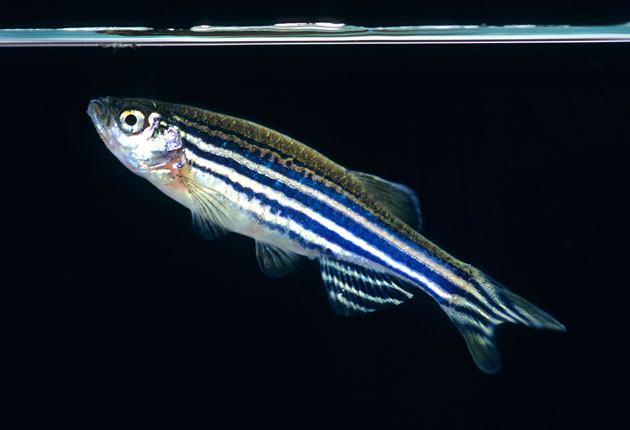An Introduction to the Zebrafish: Danio Rerio
6/3/2014
JoVE Science Education Database. Model Organisms II: Mouse, Zebrafish, and Chick. An Introduction to the Zebrafish: Danio rerio. Journal of Visualized Experiments, Cambridge, MA, doi: 10.3791/5128 (2014).
Zebrafish (Danio rerio) are small freshwater fish that are used as model organisms for biomedical research. The many strengths of these fish include their high degree of genetic conservation with humans and their simple, inexpensive maintenance. Additionally, gene expression can be easily manipulated in zebrafish embryos, and their transparency allows for observation of developmental processes.
This overview video first introduces basic zebrafish biology, including their phylogeny, life cycle, and natural environment, before presenting the features that make them so useful in the lab. A brief history of zebrafish research is also provided through a review of major discoveries made in fish, ranging from the early establishment of methods for efficient genetic screening to the discovery of novel therapeutics for human diseases such as cancer. Finally, some of the many avenues of experimentation performed in zebrafish are discussed, including immunological and developmental studies.
Zebrafish Maintenance and Husbandry
The zebrafish (Danio rerio) is a powerful vertebrate model system for studying development, modeling disease, and screening for novel therapeutics. Due to their small size, large numbers of zebrafish can be housed in the laboratory at low cost. Although zebrafish are relatively easy to maintain, special consideration must be given to both diet and water quality to in order to optimize fish health and reproductive success.
This video will provide an overview of zebrafish husbandry and maintenance in the lab. After a brief review of the natural zebrafish habitat, techniques essential to recreating this environment in the lab will be discussed, including key elements of fish facility water recirculation systems and the preparation of brine shrimp as part of the zebrafish diet. Additionally, the presentation will include information on how specific zebrafish strains are tracked in a laboratory setting, with specific reference to the collection of tail fin samples for DNA extraction and genotyping. Finally, experimental modifications of the zebrafish environment will be discussed as a means to further our understanding of these fish, and in turn, ourselves.
Zebrafish Reproduction and Development
The zebrafish (Danio rerio) has become a popular model for studying genetics and developmental biology. The transparency of these animals at early developmental stages permits the direct visualization of tissue morphogenesis at the cellular level. Furthermore, zebrafish are amenable to genetic manipulation, allowing researchers to determine the effect of gene expression on the development of a vertebrate with a high degree of genetic similarity to humans.
This video provides a brief overview of the major phases of zebrafish development, with particular focus on the first 24 hours post fertilization (hpf). The discussion begins with a zygote consisting of a single cell, or blastomere, atop a large ball of yolk. Cleavage of the blastomere is then shown to produce an embryo containing thousands of cells within a matter of hours. Next, the dramatic cellular movements known as epiboly and gastrulation are explained, revealing how they contribute to reshaping a mass of cells into a moving embryo with a beating heart in just 1 day. The presentation follows embryo development through the hatching phase, when they become swimming, feeding larvae. Important considerations for caring for larvae are incorporated, including a brief review of how fish are raised to adulthood in a dedicated facility known as the nursery. Finally, the video concludes with some common techniques utilized for studying embryo development, demonstrating how zebrafish are used to help us better understand human development and disease.
Zebrafish Breeding and Embryo Handling
Zebrafish (Danio rerio) are an important model organism that is particularly valuable for research in developmental biology. Zebrafish are extremely fertile and can produce hundreds of progeny per week, so it is relatively easy to collect a large number of embryos for high sample numbers. Furthermore, zebrafish undergo rapid development and embryos are transparent, allowing for easy visualization of developmental processes.
This video covers the steps required for the collection of newly fertilized zebrafish embryos. A brief overview of zebrafish mating behavior is presented, followed by instructions for setting up crosses in specialized laboratory breeding tanks that allow for controlled mating. Also covered are the conditions required to initiate the release of eggs (known as spawning) the morning after tanks are set. Next, essential techniques for working with embryos are presented, including the inhibition of pigment development with the chemical PTU, and dechorionation: a procedure in which the shell-like membrane surrounding the embryo (the chorion) is removed. Finally, the video concludes with some practical applications of these techniques in developmental research.
Zebrafish Microinjection Techniques
One of the major advantages to working with zebrafish (Danio rerio) is that their genetics can be easily manipulated by microinjection of early stage embryos. Using this technique, solutions containing genetic material or knockdown constructs are delivered into the blastomeres: the embryonic cells sitting atop the yolk of the newly fertilized egg. Delivery into the cytoplasm is achieved either through direct injection into the blastomere, or via natural cytoplasmic movements that occur after a solution is injected into the yolk. Successful genetic manipulations are usually followed by quantification of embryonic phenotypes in order to elucidate the genetic mechanisms of development.
This video will provide an introduction to carrying out microinjections in zebrafish embryos. The discussion begins with a review of the essential tools for the technique, including the injection apparatus and the microinjector, which controls fluid movement with pressure pulses of air. Next, important preparatory steps are demonstrated, such as the pouring of agar plates to stabilize embryos during injection and calibration of the microinjection apparatus. The injection procedure is then presented along with tips on when and where injections should be performed. Finally, applications of the microinjection technique are discussed, including gene overexpression via mRNA injection, gene silencing by delivery of antisense morpholino oligonucleotides, and the generation of transgenic zebrafish using specially engineered plasmid DNA.

 Immune & Epithelial Interactions
Immune & Epithelial Interactions




